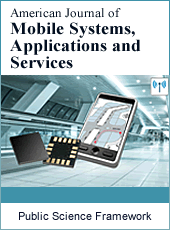American Journal of Mobile Systems, Applications and Services
Articles Information
American Journal of Mobile Systems, Applications and Services, Vol.4, No.2, Jun. 2018, Pub. Date: Aug. 31, 2018
Improving Long Term Evolution Network Signal Quality Using Resource Block Allocation
Pages: 6-12 Views: 2002 Downloads: 639
[01]
Eli-Chukwu Ngozi Clara, Department of Electrical & Electronics Engineering, Alex Ekwueme Federal University Ndufu-Alike, Ebonyi State, Nigeria.
[02]
Onoh Greg Nwachukwu, Department of Electrical & Electronics Engineering, Enugu State University of Science and Technology, Enugu State, Nigeria.
With every passing day, the importance and number of people that uses data services experiences a geometrical growth. From product survey and testing, marketing and advertisement of products, online sales and purchase of products, execution of employee training and development programs, multimedia conferencing, advance research programs and the likes, the use of Long Term Evolution (LTE) technology has no limit. But all these afore-mentioned merits are marred by poor network signal quality which is an integral part in measuring the network Quality of Service (QoS). To improve the network signal quality using block call allocation, data traffic sessions (drive test) were conducted in Port-Harcourt cluster for the existing LTE networks daily for twelve (12) weeks using a pre-defined test route. Result showed a network signal quality improvement of 13.02% and 25.87% for 1 and 2 units rise in the allocated Resource Blocks (RBs) respectively.
LTE, QoS, Data Traffic Sessions, Network Signal Quality, Resource Blocks
[01]
Martin-Sacristan D, et al (2009): On the way towards 4th-generation mobile: 3GPP LTE and LTE-advanced, EURASIP Journal on Wireless Communication and Networking 2009.
[02]
Thilagavathi J. and Meena K (2014): Assessment of Quality-of-Experience for Video Streaming over LTE Network. International Journal of Computer Science and Information Technology & Security (IJCSITS), ISSN: 2249-9555 Vol. 4, No. 1, February 2014.
[03]
Osman N. C, Seppo H, Jyri H, (2010): Analysis of antenna parameter optimization space for 3GPP LTE, Institute of Electrical Electronics Engineering 2010.
[04]
Zulhasnine M, Huang C, Srinivasan A, (2010): Efficient resource allocation for device-to-device communication underlaying LTE network, Institute of Electrical Electronics Engineering 2010.
[05]
Afroz F. et al (2015): SINR, RSRP, RSSI AND RSRQ measurements in Long Term Evolution networks. International Journal of Wireless & Mobile Networks (IJWMN) Vol. 7, No. 4, August 2015.
[06]
Chayon H. R et al (2017): An Improved Radio Resource Management with Carrier Aggregation in LTE Advanced. Applied Science Vol. 7, No. 394, April 2017.
[07]
Thomas J, Irina B, John T, Ingrid M, Thomas K, (2010): Handover parameter optimization in LTE self-organizing networks, Institute of Electrical Electronics Engineering 2010.
[08]
Parikh J and Basu A. (2016): Effect of Mobility on SINR in Long Term Evolution Systems. ICTACT Journal on Communication Technology, March 2016, Volume: 07, Issue: 01.
[09]
Luan L. et al (2012): Optimization of Handover Algorithms in LTE High-speed Railway networks. International Journal of Digital Content Technology and its Applications (JDCTA) Volume 6, Number 5, March 2012.
[10]
Harald E, Siegfried K, Marcus G, (2011): Vertical antenna tilt optimization for LTE base stations, Institute of Electrical Electronics Engineering 2011.
[11]
Kwan R, Leung C, Zhang J, (2009): Proportional fair multiuser scheduling in LTE, pp 461 – 464, Institute of Electrical Electronics Engineering 2009.
[12]
Rihonen T, Werner S, Wichman R, (2009): Optimized gain control for single-frequency relaying with loop interference, Institute of Electrical Electronics Engineering 2009.
[13]
Xiaowen L, Qianjun F, Liuwei S, (2011): An effective SINR link to system mapping method for CQI feedback in TD-LTE system, Institute of Electrical Electronics Engineering 2011.
[14]
Castellanos U. C, et al (2008): Performance of uplink fractional power control in UTRAN LTE, Institute of Electrical Electronics Engineering 2008.
[15]
Cainey J et al (2014): Modelling Download Throughput of LTE Networks. 10th IEEE International Workshop on Performance and Management of Wireless and Mobile Networks.

ISSN Print: 2471-7282
ISSN Online: 2471-7290
Current Issue:
Vol. 5, Issue 1, March Submit a Manuscript Join Editorial Board Join Reviewer Team
ISSN Online: 2471-7290
Current Issue:
Vol. 5, Issue 1, March Submit a Manuscript Join Editorial Board Join Reviewer Team
| About This Journal |
| All Issues |
| Open Access |
| Indexing |
| Payment Information |
| Author Guidelines |
| Review Process |
| Publication Ethics |
| Editorial Board |
| Peer Reviewers |


